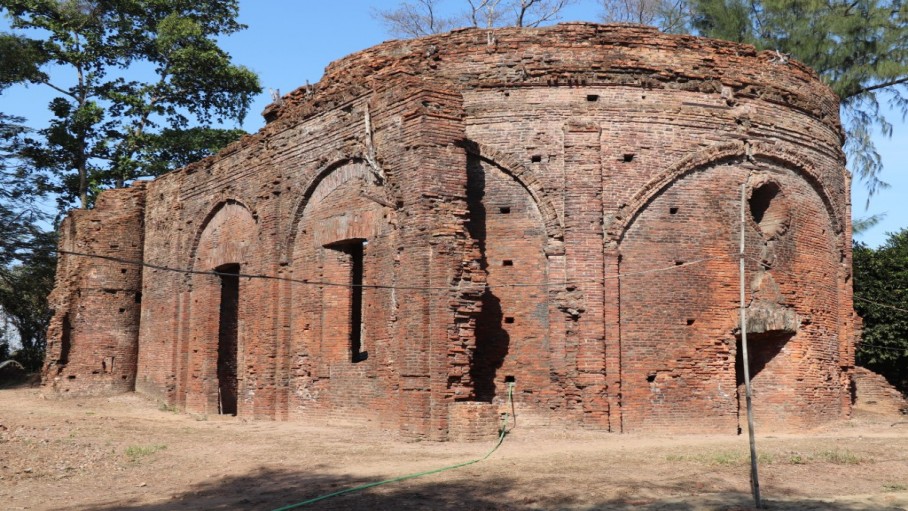Radio Veritas Asia Buick St., Fairview Park, Queszon City, Metro Manila. 1106 Philippines | + 632 9390011-15 | +6329390011-15
AN OLD CHURCH IN THAN HLYIN
AN OLD CHURCH IN THAN HLYIN
- Than Hlyin known as Syriam in the British Colonial times was once one of Myanmar’s seaport towns which thrived on oversea trade and commerce. From the 16th to the middle of the 18th centuries it had commanded the sea lanes in the South East Asian waters, and its maritime importance was no less than those of its contemporaries Penang, Malacca and Jakarta. The Arabs, the Armenians, the Portuguese, the Dutch, the French and the English who arrived there one after another at different times, to trade, to repair or build galleons, to open factories or to serve under Myanmar kings and meddle in the local politics. But after King Anaukhpet Lun besieged it and broke up the Portuguese stronghold there in 1613 and later King Alaungpaya suppressed his enemies there in 1756, this seaport town was relegated to the background.
- Among old monuments which still stand in Than Hlyin which is now easily reached in half an hour from Yangon by car on the Than Hlyin Bridge, is an old Roman Catholic Church in ruins on a hillock locally called Shin Mwe Lun Kone. Because the Portuguese had controlled Than Hlyin for 13 years (A.D. 1600-1613) the church is mistakenly thought to be an old Portuguese church. But the two inscriptions sheltered in a small brick house inside the church give us its history.
- One is a tombstone with inscriptions in Portuguese and Myanmar. The Portuguese says,
Here lies Maria Dias, aged 48, mother of Antonio Fernande, expired in March 1732.
R. I. P.
- Some portions of the Myanmar inscription have been weathered. A loose rendering into English is as follows:
“ . . . year, second waning moon of Tabaung (March) on the 4th day (Wednesday) . . . the mother of Preacher Yarnate. . . aged 48 followed the course of Karma (passed away).”
- The other is a Latin inscription of 10 lines in relief letters on a metal plate of 34 inches by 22 inches, which says that the church is dedicated to Virgin Mary, and that it was built in 1750 by an Armenian Nicolai de Aguilar and Margarita, his wife. Below the floral frame of the plate are two lines of Armenian letters which tell us that the church was built in 1750 in ever loving memory of Agatt, the son of Mr. Nicholas and wife. The church and the tombstone are not associated with the Portuguese, neither are the two inscriptions related. The Portuguese communities in Than Hlyin were deported upcountry after their gang-leader Phillipe de Brito was punished and put to death in A. D. 1613. The tomb-stone inscription is 18 years earlier than the church. When it was first discovered in the Burma Oil Company compound in the early days of the British Colonial Rule, it was removed into the church. It is not the tombstone of de Brito as the locals believe it to be.
- By Notification No. 303 dated the 10th August 1908, the Government had declared the old church to be a protected monument under the Ancient Monuments Preservation Act of 1904. Since then both the church and the two inscriptions have come into the custody of the Archaeology Department which has compiled a brief history of the old church as follows:
The church was erected in 1749-50 A. D. by Monseigneur Nerini, the second Vicar Apostolic of Ava and Pegu, and a member of the Barnabite Mission, which laboured in Pegu in the 18th century. The major part of the expenses of the erection was borne by Nicolai de Aguilar, a wealthy Armenian Merchant. The form of the building is thus described by Monseigneur G. M. Percoto, Missionary to the Kingdom of Ava and Pegu and Bishop of Massulis:
“In plan it consisted of a single nave, ornamented with arches and columns both inside and out. Its dimensions were as follows: Length 81, breadth 38, and 40 French feet. It was intended to have a domed roof, but the arrival of the Coromandel workmen, who were sent for to construct it, was prevented by the war, which arose, and the roof was therefore completed in another style. The whole building was a marvel to Peguans, but what they more especially admired was a spiral staircase going up inside the tower.”
- In A Description of the Burmese Empire, 1885, Rangoon by Father Sangermano, there is a note added by John Jardine, President of the Educational Syndicate of British Burma in which he quoted Monseigneur G. M. Percoto on the description and the service of the church as follows:
“. . . a rich Armenian and his wife finding the money, Nerini built a splendid church, with only one nave adorned with arches and columns within and without,” and with a bell-tower so high as to make the Peguans marvel. A Latin description of 1750 commemorated the Armenians, whose names were Nicholas de Aguilar and Margarita, his wife. The people met in the church at the sound of the bells; baptisms were performed with solemnity; they made processions and went singing psalms through the squares and the streets, and everything was done as in Italy. For the boys many schools were made of geography, arithmetic, navigation, and such sciences and arts as might be useful to them, and over all Father Nerini Presided, untiring, day and night.”
Today only the shell of this old church remains with the two inscriptions housed inside it. Day trippers go to Than Hlyin to get away from the hurly-burly of Yangon and to recapture the heyday of the old seaport and imaginatively reconstruct the picture of a 246 year old Armenian church of the Barnabite Order.
http://www.myanmar.gov.mm/Perspective/persp1996/10-96/old.htm (accessed on 9 July 2010)
Counted from the year 1996 when this paper was written.




Add new comment